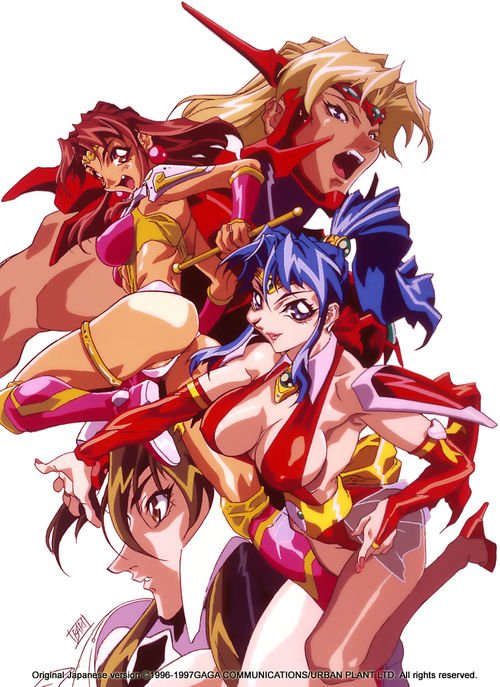
You’re watching a show, and suddenly it happens: the story cuts to a scene of a naked woman about to take a shower. Her breasts — huge and gravity-defying — jiggle and roll as she enters the shower stall, and at some point after she is wet, she presses them against the plate glass door of the shower for added effect. Then, for no apparent reason, the male protagonist in the story enters the bathroom, and comedy ensues as the man, embarrassed at seeing the woman’s bare breasts, somehow trips and falls face-first into her décolleté. Has your movie suddenly detoured into porn? Not if you’re watching a show from Japan. Instead, you ‘re probably experiencing a phenomenon known as fan service.
Fan service is a curious, Japanese cultural export found in illustrated works like graphic novels and animated films. Often, fan service amounts to nothing more than a scene of gratuitous nudity in the midst of a story, but it can also occur outside the main body of the story as an addendum or prologue (with graphic novels) or in the opening or closing credits to a popular animated TV show. Before I give any examples, I should introduce two Japanese terms.
First, there is manga or serialized comics. Manga (the form is both plural and singular) are typically printed in black ink on low-quality paper, and released in magazines a chapter at a time. They represent a huge print industry in Japan — $3.6 billion in sales in 2007 — and the more popular stories typically end up collected into volumes. The record-setting Kochikame has run for 35 years and been collected into 190 volumes, but many manga end up as a one-shot graphic novel.
Second, there is anime which are animated shows either serialized for television or released in theaters. Theatrical releases may be stand-alone films but are often derivative stories that retell a popular televised show in a condensed format or they may act as bridges between major story arcs within a serialized show. Both anime and manga cover just about every possible genre — quite a few specific to Japanese culture — and are enjoyed by audiences of all ages.

Fan service is primarily found in stories aimed at teenage boys, and can encompass all manner of scenes including full nudity, an up-skirt shot of a woman’s panties, or illustrating female characters with ridiculously large breasts. A more subtle form occurs when a story includes a titillating plot line such as a female character entering a beauty pageant or bikini contest to raise money — a thinly-veiled excuse to undress a female character. Almost any female character, including underage girls, will receive fan service treatment, and there is no deference made to women with important social roles, status, or accomplishments. All types of women, except perhaps elderly women, are depicted and venerated as sex objects: mothers, scientists, military leaders, schoolgirls — basically any female protagonist. The presumption that underlies this phenomenon is that the audience wants to see female characters depicted as sex objects at least once in a story.

Still, a narrow focus on fan service and its sexualization of female characters yields some intriguing insights into Japanese culture. One defense of fan service is that it is a candid and brave acknowledgement by heterosexual men that they are excited by women’s bodies and elect to celebrate their beauty. I agree that fan service is often presented candidly, but I would only consider it brave in the context that Japan, like America, is a country where sex is censored in mainstream media. But this defense of fan service underscores a constricted sexual outlet within Japanese culture: its titillation and shock value derive from the cultural shame attached to sex.
Women in Japan enjoy fan service, too, and examples can be found frequently in the world of “boy’s love” comics. Boy’s love, BL for short, is a genre specific to Japan that features men, often high school age, exploring gay sex and love. The writers of BL comics are most often women writing for women readers (gay men have their own, separate genre), and they may be under pressure from their editors to eroticize their storytelling and ramp up the titillation value.
A typical BL story will have at least one scene with male characters engaged in tastefully censored gay sex, but not all writers are comfortable with eroticizing their work and instead prefer to focus on the emotions experienced during love. So in order to appease their fans, they will add a prologue or mini scene at the end of the main story and create a stand-alone sexual encounter between the main characters. This is, in a sense, giving the fans what they want while still preserving the art of story-telling.
If fan service doesn’t sound like such a foreign concept, it’s because we Americans have our own analogs in film and TV. Movies marketed to teen audiences often include gratuitous nudity/semi-nudity of female and, less frequently, male characters. And particularly in action films that feature female protagonists, there is an expectation that the main character will be attractive and dress in a seductive manner (think of the characters Lara Croft from Tomb Raider or Alice from the Resident Evil series).

But Japanese fan service is multi-faceted and includes much more than the obvious gratuitous nudity. It is a broad term that includes any extra scenes in a story that cater to the desires of a fan following as well as inter-textual references within a genre. For example, in a science fiction comic, the writer may include extended illustrations that showcase a giant, transforming robot from multiple angles. The extra shots do not contribute to the story, but the fans will delight in the drawings and may rush out to buy toys based on the series. And because certain genres often have a devoted fan following, writers will indulge them with references to other popular stories they may have already read — imagine the cast of a Star Trek movie re-enacting a classic scene from the Star Wars film franchise.
Another popular form of fan service is to dress up a story’s cast in unusual outfits and place them in highly-stylized settings. The popular boy’s show, Bleach, features new opening and closing credits each season, and in one season, the closing credits depicted the opposing sides of an adversarial cast — including characters that had been killed — redrawn as companions in a film-noir setting. Some of the characters in serialized stories draw huge fan-followings over time, and writers play to their appeal.
For my part, I enjoy fan service when it is quirky or occurs outside the main body of a story. I find that gratuitous nudity and female characters with grossly disproportionate anatomy detract from the value of a story — instead of allowing you to remain immersed in the plot, they jar you back into reality and remind you that writer is merely catering to their audience. I might also add that media representations of women as idealized, pin-up type models is demeaning and horribly damaging to women’s self esteem, and that alone is reason enough to forego it.

To have a more balanced view of this cultural artifact, I even tried watching three episodes of the popular TV show, Free!, to experience gender turnabout: the story of Free! follows a boy’s high school swim team, and every episode is filled with adolescent boys in Speedos and swimsuits. But as much as I wanted to invest myself in the story and the growth of the characters, I found myself repulsed by the unnecessary fan service: the camera angle frequently focused on crotch shots and in one scene even shot through and between the legs of the team captain who was wearing a Speedo swimsuit. And while I’m sure the show has an avid following of girls and boys that look forward to each new episode (or maybe they just re-watch old episodes in slow-motion), the fan service was so heavy-handed as to ruin the story for me.
I can see how nudity and semi-nudity appeal to younger audiences or adolescents, but for mature audiences, the novelty has usually worn off. And while fan service is a phenomenon solidly ensconced in Japanese culture, I find it is an unrefined flavor that depreciates my viewing and reading experience. Instead of enjoying fan service, I prefer that writers place the material outside of the main narrative and preserve the flow of story-telling; and that, to me, seems like a sensible compromise to the issue.
By Spriggan Radfae
Follow us!Share this post with your friends.
